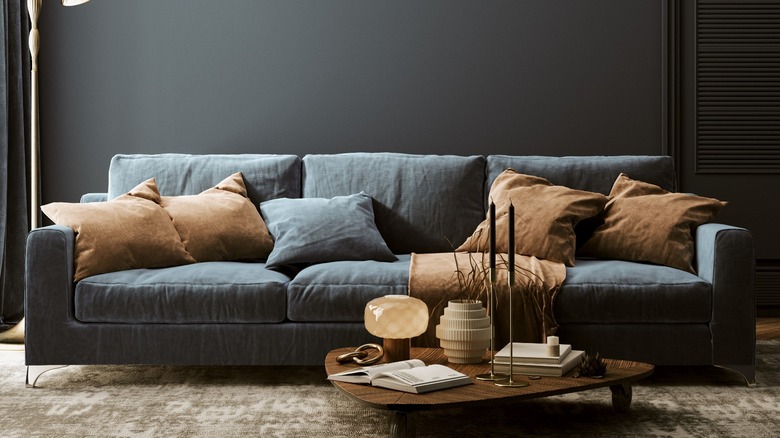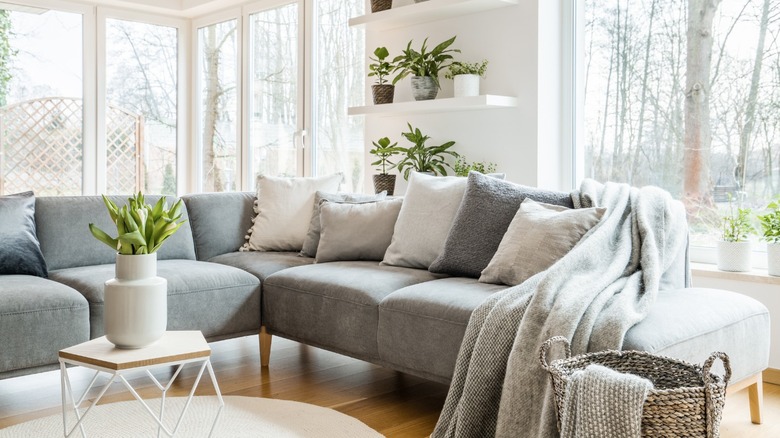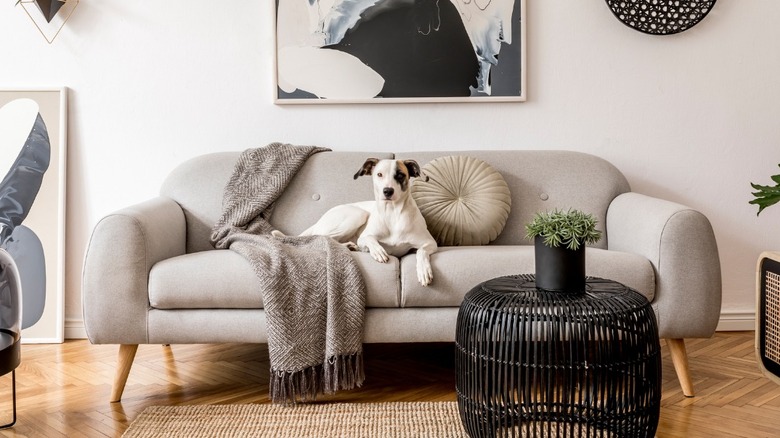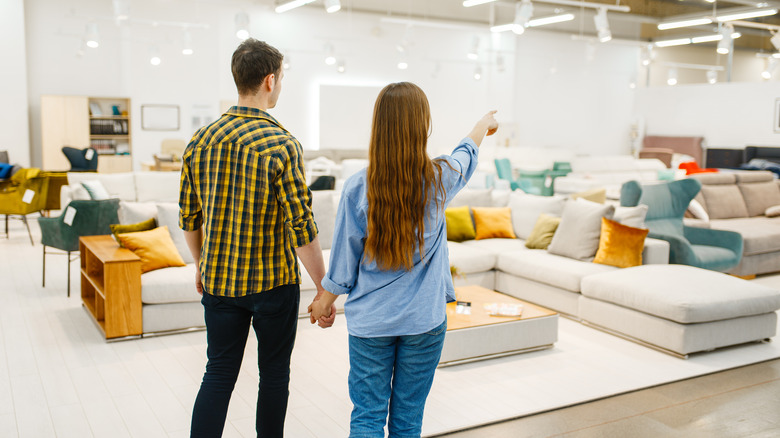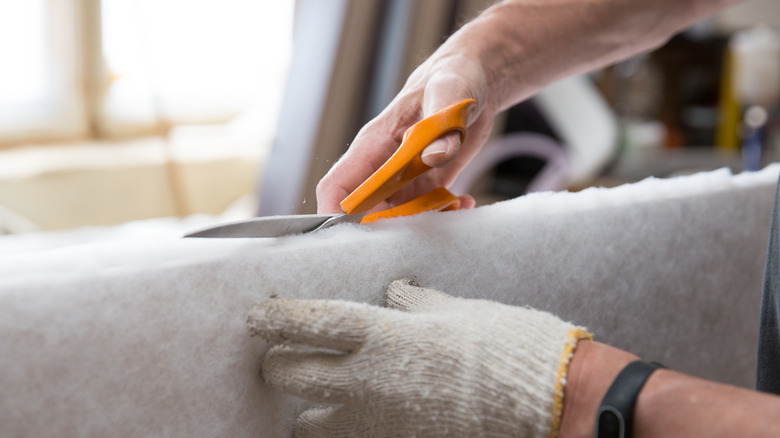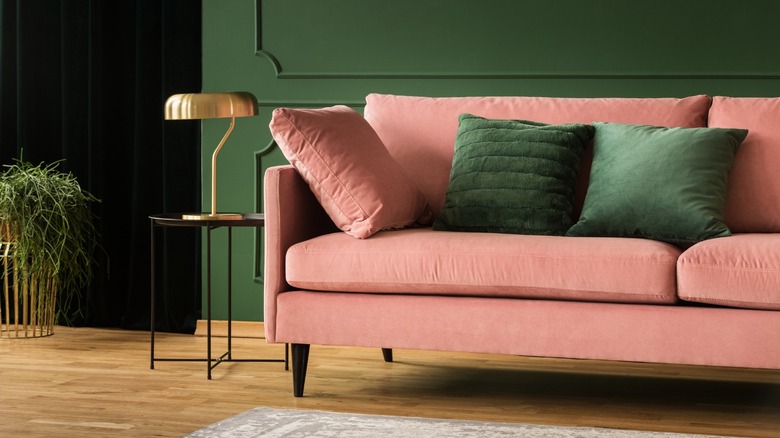How Much Does It Cost To Get A New Couch?
Buying a new couch, or sofa, can feel like a major investment, with even the lowest cost options topping out above $500 not including insurance, taxes, or delivery fees. Add to that long hours hunting for the right style and waiting for it to finally arrive; it's enough to make continued lounging on the familiar stand-by all too appealing. But if the piece is cracking, sagging, or has simply reached the end of its usefulness, it's time to get off the cushions and dive into the world of sofa shopping.
Searching for a new couch is one of those activities that gets more complicated and specified the further one gets into it. There are considerations regarding budget, style, quality, size, and fabrics. We would suggest narrowing things down by asking yourself some direct questions. How should it function? What mood would you like to create? And how much can you afford to spend? Homes & Gardens explains that costs can range from under $1,000 for a mass-produced item to over $5,000 for custom furniture. Quality will be reflected in the price. Since a sofa is both the focal piece of the living room and the first place most people take a load off after a long day, it's important to invest what you reasonably can. Below, we explore common concerns regarding committing to a new couch, and clarify what good value might mean for you.
Determine size
Home of Cozy explains that standard sized sofas are 84 inches long and 35 inches deep. Smaller apartment sized versions are available if you're low on space, while oversized pieces are options for filling more square footage. Measure the room to determine the maximum sofa dimensions, remembering to factor in space for side tables. House Beautiful notes that we should think about whether we like to lay down, lean into a high back, or sit cross-legged, as these factors can impact dimensions. In addition, you'll want to ensure clearance between the sofa and the rest of the pieces in the room so nothing touches or overlaps.
The Decorologist cautions against the conventional sofa and loveseat combination due to the limited ways you can arrange them in a room. Instead, she suggests either two identical sofas or one sofa with two chairs. The Decorologist also says to avoid an L-shape in your layout. Large pieces can face each other or be spread out to create more than one seating area.
Sectionals with a chaise provide a casual and modern alternative to the lone couch. With an orientation particularly suited to the room layout, they'll bring a custom feel to your design. Good Housekeeping says a sectional can range from $1,000 to $10,000, with costs affected by size, materials, and quality. Taking accurate measurements, including doorway openings into the room, is key when purchasing a sectional.
Understand the function
How is the sofa meant to function? Of course, it's there to be sat upon, but how often and how gently? Will it be placed in an infrequently occupied sitting room or a hectic family room? You may want something deep and plush for a living room, with lots of comfy seating for movie watching. And if it's the family's favorite lounging spot, maybe you're fine with splurging on quality that will hold up to excessive use. For a space that sees little action, less durable materials could suffice. What about a teen hangout? For a game room, perhaps something inexpensive that allows a sense of easiness may be just the ticket. Homes & Gardens makes a point for considering additional details, noting that families with small children might want a sofa that goes nearly to the floor, so as not to be losing things underneath it. Fabric colors can also come into play if there is concern around staining. In addition, the outlet recommends foam filling for pieces used often, as opposed to down, which needs constant plumping.
The number one tip shared by House Beautiful in their sofa buying guide is to try the furniture out before purchasing. A sit test will help you learn if the proportions, degree of firmness, and cover application are satisfactory. House Beautiful also suggests investing in a solid hardwood frame for furniture meant to last, a topic we'll explore in more detail later.
Select a style
With your budget, dimensions, and function somewhat nailed down, HGTV recommends devoting some time to figuring out which couch styles appeal to you the most. Do you prefer a tight-back option, which is more firm but always appears neat? Or a loose-back, which offers more comfort but needs at least occasional straightening? A three-cushion version or solo bench seat? Delicate and high legged or overstuffed and hugging the floor? Seemingly limitless designs are available across price points. Cost will be determined by the quality of the materials and construction more than the look, although additional details such as piping, tacks, removable slipcovers, or throw pillows can add to it.
Many retailers offer buildable models. You'll begin with a frame and then choose from a selection of arm, leg, and cushion styles. Generally there is little difference in cost among these preferences. Finally, the measurements and fabric applications are decided upon, determining the end price. This allows for a very customized experience and may even lower the price tag. One drawback to custom-ordered furnitures is that from time to time there may be supply chain issues. If there is less stock available it could take longer to both build and ship these pieces, which can impact costs and time frames across the board, per Penn Live. To sum it up, an off-the-shelf piece will usually equate to a quicker and less expensive option, but allows less opportunity for personalization.
What's inside matters
Many don't do enough research regarding what makes a good quality couch, asserts Wirecutter. The outlet explains that the frame, suspension, and type of cushions can mean the difference between a piece that lasts two years or twenty. They toured furniture manufacturing facilities to see couches being made and discovered that a big determiner of quality is the frame — in particular, the kinds of woods utilized and their method of construction. Homes & Gardens recommends solid wood, and Wirecutter agrees, specifically citing hardwoods such as maple and alder as ideal, while encouraging consumers to steer clear of items composed mainly of medium density fiberboard (MDF). Frames constructed with wooden dowel joinery, metal bracketing and screws, and corner reinforcing blocks are more durable than those held together with only staples and glue, per Remodelista. Some manufactures offer frame guarantees for as long as the lifetime of the piece.
For best quality and ride, one should confirm the suspension system is either hand-tied or sinuous springs as opposed to anything labeled web-suspension. Furniture First explains web seating as 2 to 3 inch long bands tacked across the frame to fashion a hammock-style support for the cushions. Finally, in regard to cushion material, House Beautiful rates down filling as the most comfortable. Conversely, foam and fiber cushions may lack structure and flatten with use. The outlet suggests a combination of the two materials as a good compromise for function and comfort.
Choose a fabric
Remodelista asked interior designer Rita Konig for her top sofa fabric suggestions. She relayed that mohair is extremely durable, though expensive, and printed fabric is adept at disguising stains. Konig is also a fan of cotton, leather, and wool — natural but strong textiles. If there are children or pets, or if your family has a habit of eating while on the couch, consider performance fabrics, which are generally polyester-based making them stain and moisture resistant. The look of the textile will impact the design visually, but its feel, called the hand, is even more imperative. The priority should be softness and comfort. You may be put off by anything scratchy, silky, or cold like leather, which is notoriously chilly for some people.
There are a variety of textiles that can be perceived as soft or cozy, and that's not exclusive to natural fibers. Use your sense of touch to help decide, and if you're shopping online order swatches. The cost of a sofa will depend on size and materials, as discussed, but also on the fabric application. Solid polyester is usually the least expensive option, followed by natural fibers like linen, wool, and mohair. Complicated prints can be pricey, too, but will help to hide wear and staining, and can make for an eye-catching piece. We compared the 84-inch West Elm Haven Sofa in different covers to demonstrate how fabric choice affects pricing. Polyester velvet was $1,699, linen blend weave was $1,799, and 100% cotton was $1,899.
